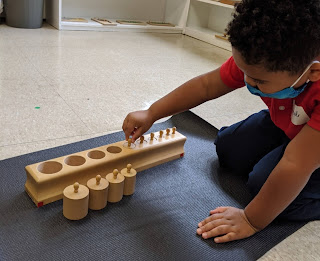A few of the beautiful moments from our in-person school days this fall:
When I first showed Joshua* a cylinder block on his first day of school, he was intrigued, and methodically took all of the cylinders in and out for the next 20 minutes
*All names changed
Marco, one of the youngest students in Redbud, came to school not knowing many letters but ready to learn, and has now mastered the phonetic sounds for the whole alphabet.
One day I suggested that Aliya, in her second year of preschool, write with the movable alphabet about things she likes to do or things she loves. Her list included movable alphabet, school, family, unicorns, [watering] plants, painting, and South America. (She is just starting to sound out words, so mostly wrote the beginning sound for each syllable.)
Naim, who had just started working with place value before we went remote in March, now easily regroups for addition with golden beads, exchanging 10 ten bars for a hundred square and 10 hundred squares for a thousand cube.
For more photos of our school year in action, see our e-newsletter.
Can you support our work to make high quality Montessori education accessible to children from all economic backgrounds? Through the end of 2020, all gifts will be matched - give now to double your impact!



















































